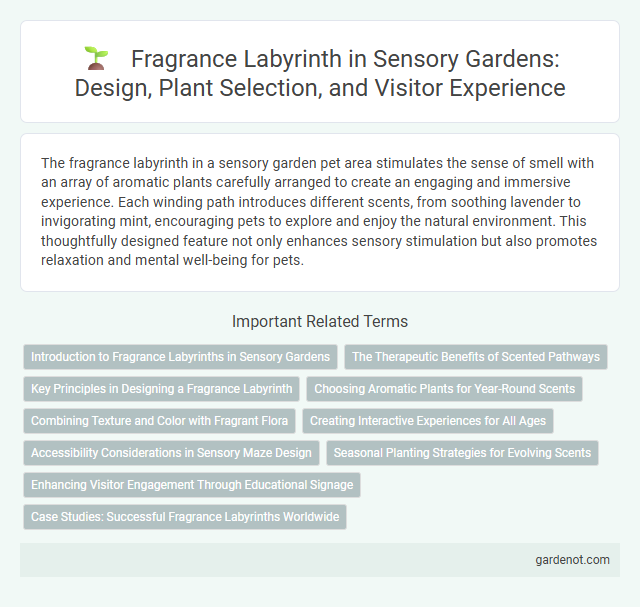The fragrance labyrinth in a sensory garden pet area stimulates the sense of smell with an array of aromatic plants carefully arranged to create an engaging and immersive experience. Each winding path introduces different scents, from soothing lavender to invigorating mint, encouraging pets to explore and enjoy the natural environment. This thoughtfully designed feature not only enhances sensory stimulation but also promotes relaxation and mental well-being for pets.
Introduction to Fragrance Labyrinths in Sensory Gardens
Fragrance labyrinths in sensory gardens enhance visitor experience by engaging the sense of smell through carefully curated aromatic plants arranged in intricate pathways. These labyrinths offer therapeutic benefits, promoting relaxation and stress reduction by stimulating olfactory senses with scents like lavender, rosemary, and jasmine. Designed to accommodate all ages and abilities, fragrance labyrinths create immersive environments that encourage mindful exploration and connection with nature.
The Therapeutic Benefits of Scented Pathways
Fragrance labyrinths in sensory gardens promote relaxation and mental clarity by stimulating olfactory receptors with carefully selected aromatic plants such as lavender, rosemary, and jasmine. These scented pathways reduce stress and anxiety while enhancing mood and memory through the therapeutic power of natural essential oils. Incorporating diverse fragrant species supports emotional well-being and cognitive function, making the labyrinth an effective tool in horticultural therapy.
Key Principles in Designing a Fragrance Labyrinth
Designing a fragrance labyrinth centers on selecting diverse aromatic plants to create a multi-sensory experience that stimulates memory and emotion. Strategic pathway layout ensures a gradual transition between scents, enhancing user engagement and encouraging exploration. Incorporating varying intensities and scent durations optimizes olfactory stimulation, making the labyrinth both educational and therapeutic.
Choosing Aromatic Plants for Year-Round Scents
Selecting aromatic plants for a fragrance labyrinth involves prioritizing species with staggered blooming periods to ensure continuous sensory stimulation throughout the year. Herbs such as lavender, rosemary, and thyme provide robust, long-lasting scents, while seasonal flowers like jasmine, gardenia, and sweet pea contribute delicate fragrances during specific months. Incorporating evergreen aromatic shrubs alongside perennial and annual plants balances intensity and variety, creating a dynamic olfactory experience in the sensory garden.
Combining Texture and Color with Fragrant Flora
A fragrance labyrinth in a sensory garden integrates diverse textures and vibrant colors through the careful selection of aromatic plants such as lavender, rosemary, and jasmine. The interplay of tactile leaves and colorful blossoms enhances the sensory experience, promoting relaxation and mindfulness. This immersive approach stimulates multiple senses simultaneously, enriching the garden's therapeutic and aesthetic value.
Creating Interactive Experiences for All Ages
The fragrance labyrinth in a sensory garden offers an immersive experience by engaging visitors of all ages through a diverse array of scented plants strategically arranged to stimulate the olfactory senses. Carefully selected herbs, flowers, and aromatic shrubs create pathways that encourage exploration and mindfulness, promoting relaxation and cognitive engagement. Interactive elements such as scent stations and guided scent discovery activities enhance the educational value, making the labyrinth a multisensory attraction for families, schools, and community groups.
Accessibility Considerations in Sensory Maze Design
Designing a fragrance labyrinth in sensory gardens requires careful accessibility considerations to accommodate individuals with mobility challenges and sensory impairments. Pathways should be wide, smooth, and free of obstacles to ensure wheelchair access, while olfactory elements must be positioned at varying heights for ease of reach and interaction. Incorporating tactile guides and auditory cues enhances navigation and enriches the sensory experience for visitors of all abilities.
Seasonal Planting Strategies for Evolving Scents
Seasonal planting strategies in a fragrance labyrinth prioritize aromatic species that bloom successively from spring through fall, ensuring a continuous evolution of scents. Early spring bulbs like hyacinths and crocuses release fresh florals, while mid-summer herbs such as lavender and rosemary contribute herbal and woody notes. Late-season choices, including autumn-scented chrysanthemums and scented geraniums, extend olfactory interest, creating a dynamic sensory experience that changes with the calendar.
Enhancing Visitor Engagement Through Educational Signage
Educational signage in a fragrance labyrinth enriches visitor engagement by providing detailed information about the aromatic plants and their sensory properties. Interactive signs explain scent profiles, botanical origins, and health benefits, transforming a passive stroll into an immersive learning experience. This approach deepens sensory awareness and encourages repeated visits to explore the garden's olfactory diversity.
Case Studies: Successful Fragrance Labyrinths Worldwide
Fragrance labyrinths have been successfully integrated into sensory gardens worldwide, enhancing visitor engagement through immersive olfactory experiences. Notable case studies include the Eden Project in the UK, which features a labyrinth designed with aromatic herbs and flowers to stimulate memory and relaxation. Similarly, Japan's Hakone Botanical Garden incorporates a fragrance labyrinth that emphasizes seasonal scents, demonstrating the powerful role of olfaction in therapeutic garden design.
Fragrance labyrinth Infographic

 gardenot.com
gardenot.com